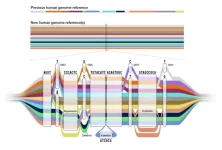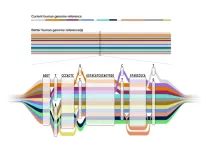(Press-News.org) Comparing individual cells across corn, sorghum, and millet reveals evolutionary differences among these important cereal crops, according to a new study led by New York University researchers.
The findings, published in Nature, bring researchers closer to pinpointing which genes control important agricultural traits such as drought tolerance, which will help scientists faced with a changing climate adapt crops to drier environments.
Corn, sorghum, and millet provide food for humans and animals around the world. Corn and sorghum are ancient relatives that evolved into two different species roughly 12 million years ago, and millet is a more distant relative.
Despite their shared ancestry, the crops have substantial differences in key traits—for instance, sorghum is far more tolerant to drought than is corn, and the plants release unique gooey substances from their roots to shape how they interact with their surrounding soil. These differences may be traced back to corn undergoing a whole genome duplication after its split from sorghum.
“The importance of these crops, their evolutionary proximity, and their functional differences present an exciting opportunity for comparing patterns of gene expression at the cell level,” said
Bruno Guillotin, a postdoctoral associate in NYU’s Department of Biology and the study’s first author. “While these three crops are similar, how they differ from each other is important because they have traits that we may want to transfer from one to the other, such as drought tolerance.”
The researchers conducted single-cell mRNA profiling of the roots of corn, sorghum, and millet, dissecting the roots to look at the cells individually and observing precisely where genes are expressed in a particular cell. They then compared the same specialized cells across the three crops.
“Roots are the first line of defense against drought and heat. You can think of the root as a machine with many working parts—in this case, cell types—so knowing how the machine works to collect water and to deal with drought and heat is really important,” said Kenneth Birnbaum, a professor in NYU’s Department of Biology and Center for Genomics and Systems Biology and the study’s senior author. “Comparing the different species helps us tease apart which genes lead to key agricultural traits.”
In examining how cells have evolved and diverged in the different species, the researchers identified several trends that point to “tinkering”—or the rearrangement of existing elements—of cells over time. First, they observed that cells often trade gene expression modules, or groups of 10 or 50 genes with coordinated functions, between cell types over evolution.
“This gene module swapping has been shown in animal systems, but the data we generated is the first time it’s been illustrated on a large level in plants,” added Birnbaum.
This swapping of modules was demonstrated in a discovery about root slime—the gooey substance filled with nutrients that roots emit into the soil. Slime is useful for lubricating the soil so roots can pass through and can attract beneficial bacteria that protect the plant or provide hard-to-get nutrients.
The researchers found that the genes that help produce root slime were located in different parts of the corn, sorghum, and millet root. In sorghum, the slime genes were found in the root’s outer tissue, while in corn these were swapped into a new cell type in the root cap, an evolutionary change that may enable corn to attract bacteria that helps the plant to gain nitrogen. They also identified other gene regulators that were switched around in different cell types depending on the crop, providing researchers with prime candidates for testing genes that convey specific traits.
In addition, the researchers found that the whole genome duplication in corn after its split from sorghum 12 million years ago affected specific types of cells, allowing corn cells to rapidly specialize. They also observed that certain kinds of cells acted as the donors of new genes while others seemed to collect new gene duplicates, which may suggest that gene duplication sped up the evolution of certain cells.
Recent advances in single-cell sequencing techniques made this research possible and open up new methods to explore the connection between genes and cellular traits in crops.
“A decade ago, we were only able to analyze a dozen or a few dozen cells with the early single-cell sequencing techniques. Now we can profile tens of thousands of cells in a pretty routine experiment,” said Birnbaum.
Future studies will compare how single cells of these three crops respond to stress, such as drought.
“It's that response that may be the key to finding that set of genes that are really important for drought tolerance,” said Birnbaum.
Additional study authors include Ramin Rahni, Carlos Ortiz Ramírez, and Sunil Kenchanmane Raju of NYU; Mohammed Ateequr Mohammed of NYU Abu Dhabi; Michael Passalacqua, Xiaosa Xu, and David Jackson of Cold Spring Harbor Laboratory; Simon C. Groen of the University of California, Riverside; and Jesse Gillis of the University of Toronto. This work was funded by the National Science Foundation (IOS-1934388), the National Institutes of Health (R35GM136362), and Human Frontiers of Science (LT000972/2018-L)
END
Crops evolved by swapping genetic modules between cells
Comparing single-cell sequencing across cereal crops provides clues about agricultural traits critical for adapting plants to climate change
2023-05-10
ELSE PRESS RELEASES FROM THIS DATE:
Behind the scenes of a major genomic discovery
2023-05-10
EMBARGOED UNTIL WEDNESDAY, MAY 10, 2023, AT 11AM ET
New York, NY (May 10, 2023)—Eimear Kenny, PhD, had just completed undergrad and was working in her first computational genomics job more than 20 years ago when scientists announced the first (nearly) complete sequencing of the human genome—what was considered at the time to be the fundamental blueprint for all humans. The Human Genome Project aimed to map the entire genome in an effort to accelerate the diagnosis and eventual treatment of common and rare diseases.
Now, Dr. Kenny, ...
Human pangenome reference will enable more complete and equitable understanding of genomic diversity
2023-05-10
UC Santa Cruz scientists, along with a consortium of researchers, have released a draft of the first human pangenome—a new, usable reference for genomics that combines the genetic material of 47 individuals from different ancestral backgrounds to allow for a deeper, more accurate understanding of worldwide genomic diversity.
By adding 119 million bases—the “letters” in DNA sequences—to the existing genomics reference, the pangenome provides a representation of human genetic diversity that was not possible with a single reference genome. It is highly accurate, more complete and dramatically increases ...
New ‘pangenome’ offers more inclusive view of human genome
2023-05-10
New Haven, Conn. — When it was launched in April 2003, the Human Genome Project helped revolutionize biomedical research by providing scientists a reference map that allowed them to analyze DNA sequences for genetic clues to the origins of a host of diseases.
Twenty years later, a team of researchers that includes Yale scientists has created a new “pangenome” that fills in missing sequencing gaps from the original genome project and greatly expands the diversity of genomes represented.
The achievement is described in ...
Study: palliative care provided at point of oncology surgery does not improve patient outcomes
2023-05-10
One of the most important advances in palliative care in oncology over the past 15 years has been the recognition that palliative care specialists can improve cancer patients’ outcomes well before their end of life.
Palliative care is specialized care provided to individuals with a serious illness that focuses on decision-making support, pain and symptom management, as well as psychosocial interventions to improve quality of life.
Several past randomized clinical trials have shown palliative care specialists can improve the quality of life and lengthen the ...
Investigating social media to evaluate emergency medicine physicians’ emotional well-being during COVID-19
2023-05-10
About The Study: In this study, key thematic shifts and increases in language related to anxiety, anger, depression, and loneliness were identified in the content posted on social media by academic emergency medicine physicians and resident physicians during the pandemic. Social media may provide a real-time and evolving landscape to evaluate thematic content and linguistics related to emotions and sentiment for health care workers.
Authors: Anish K. Agarwal, M.D., M.P.H., M.S., of the ...
Analysis of BMI in early and middle adulthood and estimated risk of gastrointestinal cancer
2023-05-10
About The Study: In this secondary analysis of the Prostate, Lung, Colorectal, and Ovarian Cancer Screening Trial, overweight and obese body mass index (BMI) in early and middle adulthood was associated with an elevated risk of colorectal cancer and non-colorectal gastrointestinal cancers. The results of the current study prompt further exploration into the mechanistic role of obese BMI in carcinogenesis.
Authors: Holli A. Loomans-Kropp, Ph.D., M.P.H., of Ohio State University in Columbus, is the corresponding author.
To access the embargoed study: Visit our For The Media website at this link https://media.jamanetwork.com/
(doi:10.1001/jamanetworkopen.2023.10002)
Editor’s ...
UW Medicine scientists among leads of NIH pangenome studies
2023-05-10
UW Medicine genome experts made significant scientific contributions to a National Institutes of Health Human Genome Research Institute reference collection that better represents the genetic diversity of the world’s populations.
Called the Human Pangenome Reference Consortium, the multi-institutional effort expands and updates earlier work that started as the Human Genome Project. That original project, with drafts reported in 2001 and 2003, was based on a more limited sampling of human DNA. The goal then was to create an entire sequence of a human genome to use as a reference. ...
The clearest snapshot of human genomic diversity ever taken
2023-05-10
For more than 20 years, scientists have relied on the human reference genome, a consensus genetic sequence, as a standard against which to compare other genetic data. Used in countless studies, the reference genome has made it possible to identify genes implicated in specific diseases and trace the evolution of human traits, among other things.
But it has always been a flawed tool. One of its biggest problems is that about 70 percent of its data came from a single man of predominantly African-European background whose DNA was sequenced during ...
Researchers measure the light emitted by a sub-Neptune planet’s atmosphere for the first time
2023-05-10
For more than a decade, astronomers have been trying to get a closer look at GJ 1214b, an exoplanet 40 light-years away from Earth. Their biggest obstacle is a thick layer of haze that blankets the planet, shielding it from the probing eyes of space telescopes and stymying efforts to study its atmosphere.
NASA’s new James Webb Space Telescope (JWST) solved that issue. The telescope’s infrared technology allows it to see planetary objects and features that were previously obscured ...
Paper refutes assertion that effects of bottom trawling on blue carbon can be compared to that of global air travel
2023-05-10
A ‘Matter Arising’ paper published in Nature today refutes the findings of a paper by Sala et al on the amount of CO2 released from the seabed by bottom trawling. The paper made significant headlines around the world on release in 2021, as it equated the carbon released by bottom trawling to be of a similar magnitude to the CO2 created by the global airline industry.
In their paper quantifying the carbon benefits of ending bottom trawling, Prof Jan Hiddink of Bangor University’s world-renowned School of Ocean Science and others, explain that the methodology ...
LAST 30 PRESS RELEASES:
How do childcare tax credits affect children’s long-term health?
Can an electronic nose detect indoor mold?
Do natural disasters have long-term impacts on mortality in older adults?
Modification improves sodium‐ion batteries as an alternative to lithium-ion batteries
Parasports provide a range of benefits for people with cerebral palsy
How does grandparental care affect children’s health?
Why are there so many Nordic mediators?
Young shark species more vulnerable to extinction
Mobile fetal heart monitoring linked to fewer newborn deaths in Tanzania
Bluey’s dad offered professorial chair in archaeology at Griffith University
Beyond small data limitations: Transfer learning-enabled framework for predicting mechanical properties of aluminum matrix composites
Unveiling non-thermal catalytic origin of direct current-promoted catalysis for energy-efficient transformation of greenhouse gases to valuable chemicals
Chronic breathlessness emerging as a hidden strain on hospitals
Paleontologists find first fossil bee nests made inside fossil bones
These fossils were the perfect home for ancient baby bees
Not everyone reads the room the same. A new study examines why.
New research identifies linked energy, immune and vascular changes in ME/CFS
Concurrent frailty + depression likely boost dementia risk in older people
Living in substandard housing linked to kids’ missed schooling and poor grades
Little awareness of medical + psychological complexities of steroid cream withdrawal
Eight in 10 trusts caring for emergency department patients in corridors, finds BMJ investigation
NASA’s Webb telescope finds bizarre atmosphere on a lemon-shaped exoplanet
The gut bacteria that put the brakes on weight gain in mice
Exploring how patients feel about AI transcription
Category ‘6’ tropical cyclone hot spots are growing
Video: Drivers struggle to multitask when using dashboard touch screens, study finds
SLU research shows surge in alcohol-related liver disease driving ‘deaths of despair’
Rising heat reshapes how microbes break down microplastics, new review finds
Roots reveal a hidden carbon pathway in maize plants
Membrane magic: FAMU-FSU researchers repurpose fuel cells membranes for new applications
[Press-News.org] Crops evolved by swapping genetic modules between cellsComparing single-cell sequencing across cereal crops provides clues about agricultural traits critical for adapting plants to climate change






